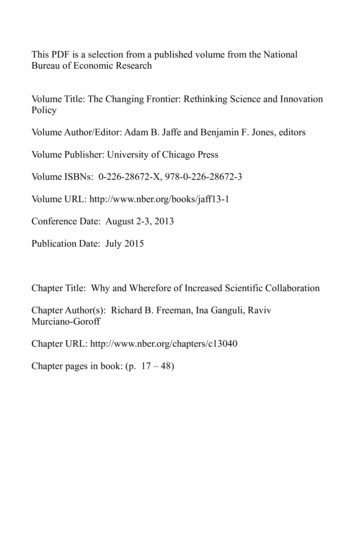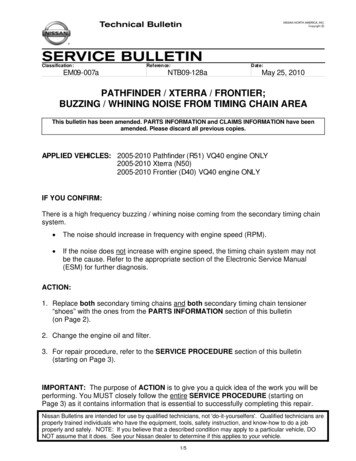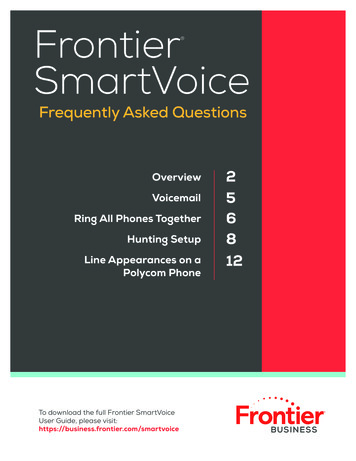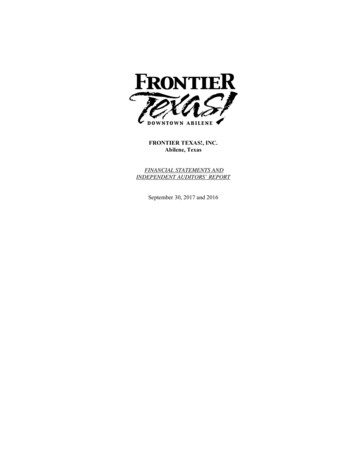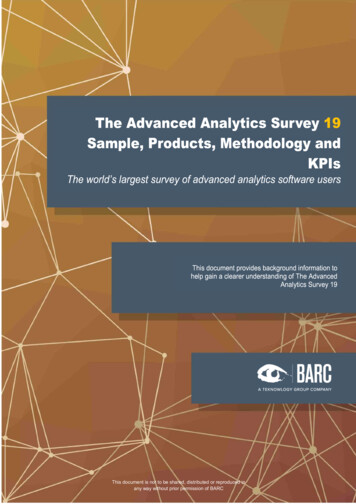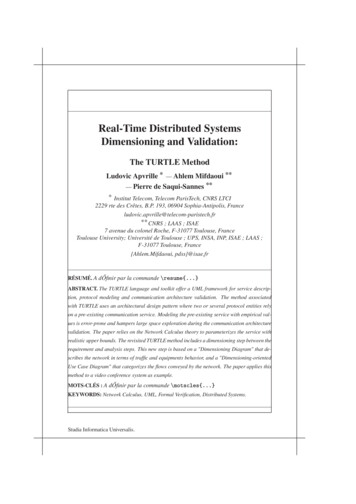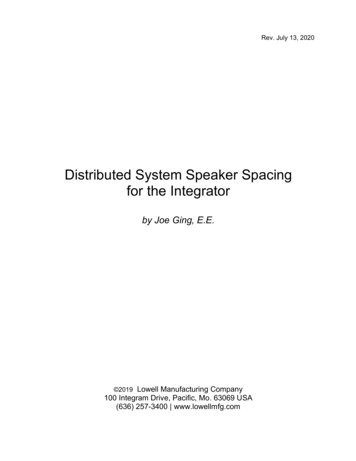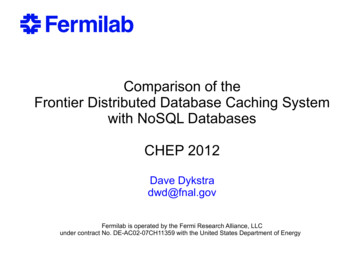
Transcription
Comparison of theFrontier Distributed Database Caching Systemwith NoSQL DatabasesCHEP 2012Dave Dykstradwd@fnal.govFermilab is operated by the Fermi Research Alliance, LLCunder contract No. DE-AC02-07CH11359 with the United States Department of Energy
OutlineGoal: increase familiarity with Frontier & NoSQL Common characteristics of NoSQL databases The Slashdot Effect Frontier Distributed Database Caching systemcharacteristics CMS Frontier/Squid deployment examples Comparison of Frontier to NoSQL in general Comparisons of specific NoSQL systems ConclusionsCHEP 2012Dave Dykstra2
NoSQL common characteristics “NoSQL” denotes a large variety of DatabaseManagement Systems (DBMS)Primary unifying characteristic: not a RelationalDatabase Management System (RDBMS)—Generally nested key/value instead of row/column Run-time flexibility, doesn't need pre-defined schemasMost don't support the RDBMS standard StructuredQuery Language SQLMost popular NoSQL DBs support being distributedand fault-tolerant – highly scalable on commodity HWMost give up atomicity of updates (ACID) and insteadhave eventual consistency (BASE)— CHEP 2012Dave Dykstra3
The Slashdot Effect Slashdot Effect (or, slashdotting): when a toosmall server is overwhelmed by the samerequest from too many clients—Named for slashdot.org, a very popular technicalnews aggregator website that often hyperlinks toless-popular sitesFor web servers, usual solution is to use aContent Delivery Network (CDN) that eitherreplicates or caches the objects around the world Some database applications have similar need CHEP 2012Dave Dykstra4
Frontier characteristics The Frontier Distributed Database CachingSystem is designed for the Slashdot Effect –many readers of same data, few writersDistributes RDBMS SQL queries (not “NoSQL”)—RESTful, so cacheable with standard web proxycaches (we use Squid)—Web caches on client premises make ideal CDN— Most network traffic on LAN, scalable as neededPractically maintenance-freeSimultaneous same requests collapsed to one—Simultaneous different requests queued in Frontierserver—CHEP 2012Dave Dykstra5
CMS Offline Frontier/SquidConditions deploymentRDBMS OfflineFrontierServersTomcat Servlet 0FarmTier1, 2, 3SquidsTier1, 2,3SquidsTierNFarmTierNFarmOnly custom software is Frontier servlet in Tomcat andfrontier client in application on worker node farmsPlanning to replicate RDBMS & Frontier servers for availabilityCHEP 2012Dave Dykstra6
CMS Offline Frontier/SquidConditions stats For Tier 0, 1, & 2 (not counting Tier 3):—Average 500,000 total Frontier requests per minute,aggregate average total 500MB/s Bursts at sites are much higher than average The 3 central server Squids at CERN only get4,000 average requests per minute, 0.5MB/s— Factor of 125 improvement on requests and 1000 onbandwidth (not counting Tier 3) Difference primarily because of If-Modified-SinceVast majority of jobs read very quickly becauseresults are already cached & valid in local SquidsCHEP 2012Dave Dykstra7
CMS Online Frontier/SquidConditions deploymentRDBMS OnlineFrontierServersTomcat Servlet SquidSquidsSquid placement is very flexible for more bandwidth—Hierarchy of Squids on every worker node—Blasts data to all 1400 nodes in parallelCHEP 2012Dave Dykstra8
Squid & Frontier limits Frontier Tomcat servlet—3-year old 8-core machine (Xeon L5420 @ 2.5Ghz): Without compression, easily saturates 1Gbit network outWith gzip compression, drops to 25MB/s out (but savesmuch bandwidth later in the caches)Adds 1/3rd overhead after gzip to avoid binary dataSquid—2-year old machine (Xeon E5430 @ 2.66Ghz): —Saturates 2Gbit network with one single-thread Squidmodern machine (Opteron 6140): Up to 7Gbps on 10Gbit network with a single-thread SquidCan get full throughput with two Squid2s on same portCHEP 2012Dave Dykstra9
Frontier vs. NoSQL in generalFrontierNoSQL in generalDB structureRow/columnNested key/valueConsistencyACID DB, eventual readsEventualWrite modelCentral writingDistributed writingRead modelMany readers same data Read many different dataData modelCentral data,cache on demandDistributed data, copiesDistributedelementsGeneral purposeSpecial purposeCHEP 2012Dave Dykstra10
Specific NoSQL systems SystemsATLAS––––currently used in production by CMS orMongoDBCouchDBHadoop HBaseCassandraCHEP 2012Dave Dykstra11
MongoDB “Mongo” for “humongous” - for big, cheap dataStores binary JSON (JavaScript Object Notation) dataMore similar features to RDBMS than most NoSQL– Any field can be memory-indexed for performance– Flexible queries By fields, ranges, and regular expressions Only one write server per data item—Copies are read-only, can take over as master if mastergoes down Scalesby sharding, splitting writing of different data todifferent servers–Not great at Slashdot effectCHEP 2012Dave Dykstra12
MongoDB cont'd Used by CMS for Data Aggregation Service(DAS)Needed the dynamic structure, liked other features—Not a big installation though, only one server—See poster 184 Thursday— Supports MapReduce for distributing queryprocessing to where the data is—An ATLAS evaluation showed this didn't work wellbut it is supposed to be better now in version 2.0 More in talk after this oneCHEP 2012Dave Dykstra13
CouchDBStores JSON RESTful interface Can use http proxy caches where needed—Also easy to insert authentication proxy—Automated, low-maintenance replication All copies get all data, all can read and write Uses MultiVersion Concurrency Control (MVCC) Feature of RDBMS – transactions, ACID—Readers get a consistent view—Writing doesn't block reading— Write conflicts have to be resolved by application, howeverCHEP 2012Dave Dykstra14
CouchDB cont'd Querying is done by creating “views” defined byJavaScript functions– Uses MapReduce paradigm for the functions butprocessing is not distributed among multiple servers Used by CMS for several Workload ManagementfunctionsCouchDB data replicated between CERN andFermilab, 3 replicas at CERN and 4 at Fermilab—Again, see poster 184 on Thursday—CHEP 2012Dave Dykstra15
Hadoop HBase HBase is built on Hadoop Distributed FileSystemHDFS automatically distributes files and replicatesthem across a cluster—Tunable replication level—Very reliable and automated for large amount of data—Good for big installations, not small— Modeled after Google's BigTableBillions of rows with millions of columns—Good for search engine-like applications— Very good at distributed MapReduceCHEP 2012Dave Dykstra16
HBase cont'dAlso has SQL and RESTful API add-ons Used by ATLAS distributed data manager for loganalysis and accounting on a 12-node cluster Original straightforward accounting summary methodwas 8 to 20 times faster than same method on ashared Oracle, depending on replication level—More in talk after this & poster 425 Thursday—HBase was recognized by the WLCG DatabaseTechnical Evolution Group as having greatestpotential impact of all the NoSQL technologies CERN IT is setting up a cluster CHEP 2012Dave Dykstra17
CassandraLike HBase, modeled after Google BigTable All nodes are masters, decentralized control forgeographically distributed fault tolerance —Dynamic re-configuration with no downtimeKeys and values can be any arbitrary data Has static “column families” used like indexes inRDBMS Tunable consistency from always consistent toeventual consistency Tunable replication level and in-memory caching CHEP 2012Dave Dykstra18
Cassandra cont'dCan do MapReduce via Hadoop add-on Originally written by Facebook, but theyabandoned it in favor of HBase Used in production by ATLAS PanDA monitoringsystem Hosted on 3 high-power nodes at BNL, 24 coreseach, 1TB of RAID0 SSDs each—See poster 359 on Tuesday—CHEP 2012Dave Dykstra19
Comparison NArbitraryArbitrarySQL typesFlexible queriesYesNoNoNoYesDistributed writeNoYesNoYesNoHandles SlashdotEffectNoYes, bestw/squidDoes well with manyreads of different dataYesYesYesYesNoRESTful interfaceNoYesAdd-onNoYesEventualACID DB,eventual readMixedTunableACID DB,eventual readNoNoYesAdd-onNoFew copiesEverythingTunableTunableCachingStored data formatConsistencyDistributed MapReduceReplicationCHEP 2012If scaledIf scaledsufficiently sufficientlyDave Dykstra20Yes
Conclusions NoSQLdatabases have a wide variety ofcharacteristics, including scalability Frontier Squid easily & efficiently adds some ofthe same scalability to relational databases whenthere are many readers of the same data–Also enables clients to be geographically distant CouchDBwith REST can have same scalability Hadoop HBase has most potential for big apps There are good applications in HEP for manydifferent Database Management SystemsCHEP 2012Dave Dykstra21
– CouchDB – Hadoop HBase – Cassandra. CHEP 2012 Dave Dykstra 12 MongoDB “Mongo” for “humongous” - for big, cheap data Stores binary JSON (JavaScript Object Notation) data More similar features to RDBMS than most NoSQL – Any field can be memory-indexed for performance – Flexible queries By fields, ranges, and regular expressions Only one write server per data item— .


